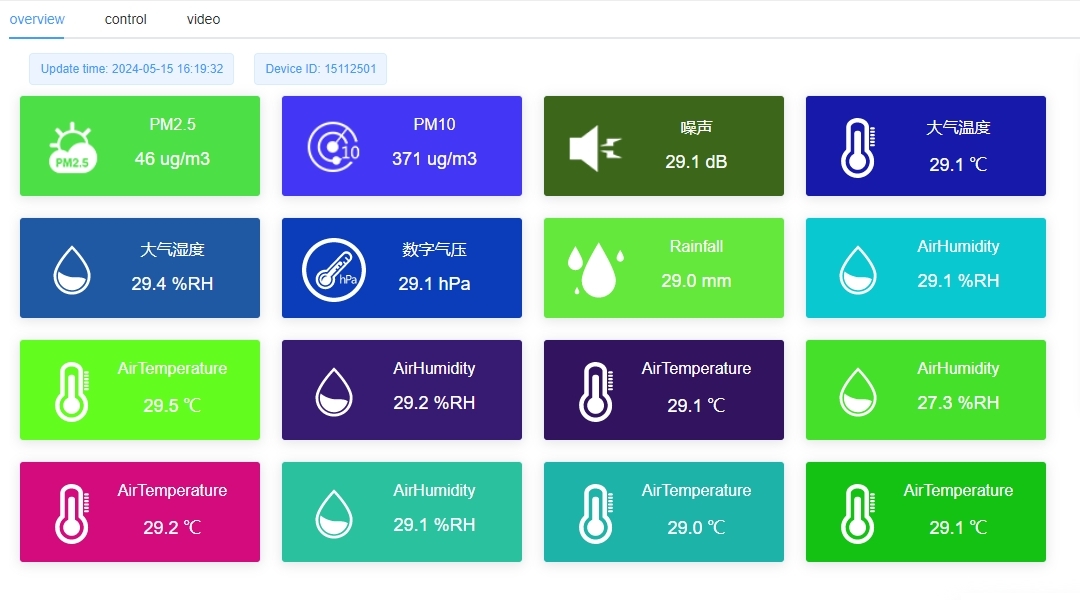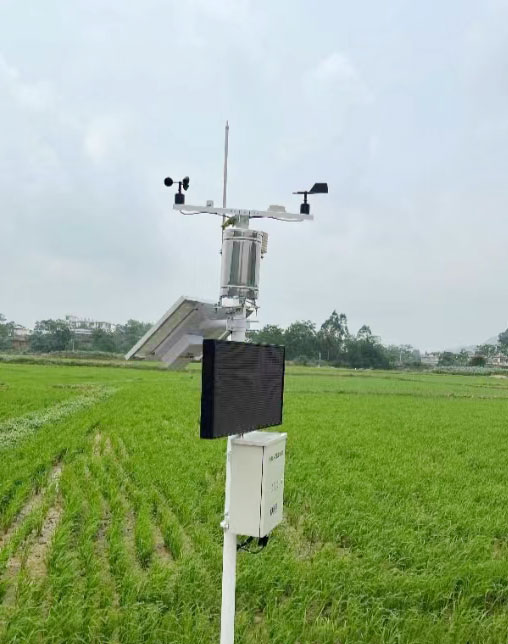

— Blogs —
—Products—
 Consumer hotline +8618073152920
Consumer hotline +8618073152920 WhatsApp:+8615367865107
Address:Room 102, District D, Houhu Industrial Park, Yuelu District, Changsha City, Hunan Province, China
Product knowledge
Time:2024-09-19 22:18:05 Popularity:314
A weather station, in short, is a system of equipment used to observe and record changes in the state of the atmosphere. It integrates a variety of high-precision sensors that can monitor key meteorological elements such as temperature, humidity, wind speed, wind direction, barometric pressure, precipitation and other key meteorological elements in real time, and transforms the collected data into valuable information by means of data processing and communication technologies. Weather stations are widely used in many fields such as meteorological observation, scientific research, environmental protection and agricultural production, providing important data support for weather forecasting, climate research and disaster warning. In this article, we will delve into the definition of a weather station, the characteristics of a weather station for farms, its importance, and the value it brings to agricultural production.
Weather Station for Farm, or Farm Weather Station, is a weather station designed specifically for the farm environment. It not only has the basic functions of a typical weather station, but is also optimized for the specific needs of agricultural production. For example, it may add sensors for soil moisture, soil temperature, light intensity, evaporation, and even crop growth related sensors, etc. By monitoring parameters closely related to crop growth, in order to provide more comprehensive and accurate agro-weather information to farm managers. Through real-time monitoring, farmers can understand the micro-environment of crop growth and make more scientific management decisions. In addition, Weather Station for Farm usually has stronger durability and adaptability, and is able to operate stably in various harsh farm environments.
1. Sensor system: this is the core part, which is used to monitor various weather elements. Common sensors include wind speed sensors, wind direction sensors, temperature sensors, humidity sensors, rainfall sensors, barometric pressure sensors, solra radiation sensors and so on. These sensors are capable of measuring wind speed, wind direction, air temperature and humidity, precipitation, atmospheric pressure, and solar radiation respectively.
2. Weather Station Rack: Provides physical support for mounting components such as sensors, solar panels, collectors, etc. The rack is usually made of corrosion-resistant materials such as stainless steel or stainless steel. It is usually made of corrosion-resistant materials such as stainless steel or rust-proof treated metals to ensure stability for long-term outdoor use.
3. Solar panels and batteries: provide energy for the entire system. Solar panels collect solar energy during the day and convert it into electricity to power the system, while batteries provide power at night or on cloudy days to ensure that the weather station works 24 hours a day without interruption.

4. Collector and Transmission Module: The collector is responsible for collecting data from the sensors and then sending the data to the backend system via the transmission module. This can be done wirelessly, e.g. via Wi-Fi/4G/Lora or dedicated telecommunication technology to ensure that the data is updated in real time.
5. Back-end computer terminal or cloud platform: the center of data reception and processing, either the user's personal computer or a cloud server. This is where data is presented and analyzed to help users make decisions. The data is usually presented in the form of graphs or reports that are easy for the user to understand and apply.
These components work in tandem to ensure that an agro-weather station can comprehensively and accurately monitor the farmland environment, provide a scientific basis for agricultural production, and help farmers optimize their planting strategies to improve crop yields and quality, as well as reduce losses from natural disasters.
Agriculture is an industry that is highly dependent on weather conditions. The frequency of extreme weather events, such as droughts, floods and frosts, poses a serious threat to crop yields. With on-farm weather stations, farmers can obtain accurate weather forecasts in advance and take precautionary measures, such as adjusting irrigation schedules, arranging crop protection measures or adjusting sowing times, thus reducing the impact of weather disasters and safeguarding healthy crop growth.
1. Improve agricultural production efficiency: real-time weather data provided by weather stations help farmers rationalize their farming activities and improve production efficiency.
2. Optimize crop planting structure: Through meteorological data, farmers can understand the local climate characteristics and choose suitable crops to plant to improve yield and quality.
3. Defense against meteorological disasters: weather stations can warn of meteorological disasters in time and help farmers take measures to reduce losses.
4. Save water resources: By monitoring soil moisture, weather stations help realize precise irrigation and save water resources.

1. Accurate decision support: The data provided by weather stations enable farm managers to make decisions based on real-time and accurate weather information, such as irrigation, fertilization, pest control, etc., thus improving agricultural production efficiency.
2. Disaster Early Warning: By monitoring extreme weather conditions, such as heavy rainfall, drought, frost, etc., the weather station is able to send out warning signals in advance, helping farm managers to take timely measures to reduce losses.
3. Optimize resource allocation: Based on the weather data, farm managers can arrange human, material and financial resources more reasonably to avoid waste of resources and over-investment.
4. Improve crop quality: By precisely controlling the growing environment, weather stations help to improve the quality and yield of crops and meet the market demand for high-quality agricultural products.
5. Promote sustainable development: the application of weather stations helps to realize the precision, intelligence and greening of agricultural production, and promote the sustainable development of agriculture.
6. Precision agriculture: Farm-specific weather stations provide farmers with detailed weather and soil data, which helps realize precision agriculture and improve crop yield and quality.
7. Cost saving: Through weather station data, farmers can rationalize agricultural production and reduce costs.
8. Eco-environmental protection: weather stations help monitor the agro-ecological environment and provide data support for eco-environmental protection.
Summarize:
Farm-specific weather station is an important tool for modern agricultural intelligence, which transcends the scope of traditional data collection tools and becomes the core of intelligence in agricultural production. By monitoring and providing accurate weather information in real time, it empowers farmers with unprecedented insights, helping them to better understand and respond to the complex changes in nature.
This intelligent system not only improves the efficiency and stability of agricultural production, but also facilitates the fine management of resources and a leap in the quality of crops. In the unpredictable climate environment, the farm weather station has become a reliable partner for farmers, laying a solid foundation for ensuring food safety and promoting stable growth of the agricultural economy.
With the continuous progress of science and technology, the application prospect of farm-specific weather station is getting broader and broader. It not only optimizes the layout of crop planting, enhances the early warning and defense capability of meteorological disasters, but also effectively saves valuable agricultural water resources. In the tide of agricultural modernization, the weather station is playing an irreplaceable role, leading the intelligent and precise transformation of agricultural production.
Therefore, farmers should actively embrace this modern agricultural tool, so that the farm special weather station to become your right-hand man in agricultural production, and jointly promote the sustainable development of agriculture, towards a more prosperous future.
Related recommendations
Sensors & Weather Stations Catalog
Agriculture Sensors and Weather Stations Catalog-NiuBoL.pdf
Weather Stations Catalog-NiuBoL.pdf
Related products
 Combined air temperature and relative humidity sensor
Combined air temperature and relative humidity sensor Soil Moisture Temperature sensor for irrigation
Soil Moisture Temperature sensor for irrigation Soil pH sensor RS485 soil Testing instrument soil ph meter for agriculture
Soil pH sensor RS485 soil Testing instrument soil ph meter for agriculture Wind Speed sensor Output Modbus/RS485/Analog/0-5V/4-20mA
Wind Speed sensor Output Modbus/RS485/Analog/0-5V/4-20mA Tipping bucket rain gauge for weather monitoring auto rainfall sensor RS485/Outdoor/stainless steel
Tipping bucket rain gauge for weather monitoring auto rainfall sensor RS485/Outdoor/stainless steel Pyranometer Solar Radiation Sensor 4-20mA/RS485
Pyranometer Solar Radiation Sensor 4-20mA/RS485
Screenshot, WhatsApp to identify the QR code
WhatsApp number:+8615367865107
(Click on WhatsApp to copy and add friends)